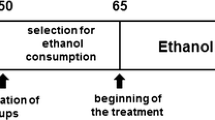Summary
This study was undertaken to elucidate the relationship between the time of destruction of the external granular layer and subsequent cerebellar abnormalities. Mice were injected s. c. with 30 mg/kg body weight (b. wt.) of cytosine arabinoside on days 2, 3, and 4, on days, 4, 5, and 6, on days 7, 8, and 9, and on days 10, 11, and 12, and designated as group I, II, III, and IV, respectively.
In group I, disarrangement of Purkinje cells and heterotopic granule cells in the molecular layer were observed on all lobes of cerebellum. Heterotopic granule cells were seen on all lobes in group II, whereas disarrangement of Purkinje cells was observed only in the region from the anterior to middle lobes. In group III, heterotopic granule cells were limited to the area from anterior to middle lobes, but there was no disarrangement of Purkinje cells. Group IV cerebellum did not show abnormal cytoarchitecture.
Golgi-Cox studies showed abnormal arborization of Purkinje cells in each experimental group. They were arbitrarily classified into inverted Purkinje cells, lying Purkinje cells, T-shaped Purkinje cells, and poorly arborized Purkinje cells. The earlier the postnatal treatment the more severe were the abnormalities of Purkinje cell dendrite.
According to the electron-microscopic study, some glomerular synaptic complexes, which are normally confined to the internal granular layer, were observed even in the molecular layer in groups I, II, and III. Some of the Purkinje cell dentritic spines did not make synapses with parallel fibers in any of the experimental groups.
The results indicate that severity of abnormal arborization of Purkinje cells is dependent on the period of destruction of the external granular layer. Formation of heterotopic granule cells was dependent on the destruction of the external granular layer up to day 10 after birth.
Similar content being viewed by others
References
Altman J, Anderson WI, Wright KL (1969) Reconstruction of the external granular layer of the cerebellar cortex in the infant rats after low-level X-irradiation. Anat Rec 163:453–472
Altman J (1976) Experimental reorganization of the cerebellar cortex. VII. Effects of late X-irradiation schedules that interfere with cell aquisition after stellate cells are formed. J Comp Neurol 165:65–76
Ebels EJ (1972) Studies on ectopic cells in the cerebellar cortex — with a hypothesis as to their aetiology and pathogenesis. Acta Neuropathol (Berl) 21:117–127
Fujita S, Shimada M, Nakamura T (1966)3H-thymidine autoradiographic studies on the cell proliferation and differentiation in the external and internal granular layers of the mouse cerebellum. J Comp Neurol 128:191–208
Fujita S (1967) Quantitative analysis of cell proliferation and differentiation in the cortex of postnatal mouse cerebellum. J Cell Biol 32:277–288
Herdon RM, Margolis G, Kilham L (1971) The synaptic organization of the malformed cerebellum induced by perinatal infection with the felin panleukopenia virus (PLV). II. The Purkinje cell and its afferents. J Neuropathol Exp Neurol 30:557–570
Hirano A, Dembitzer H, Jones M (1972) An electron-microscopic study of cycasine-induced cerebellar alterations. J Neuropathol Exp Neurol 31:113–125
Hopewell JW (1974) The permanent long-term effects of the postnatal X-irradiation on the rat cerebellum. Acta Neuropathol (Berl) 27:163–169
Jones MZ, Gardner Z (1976) Pathogenesis of methylazoxymethanol-induced lesions in the postnatal mouse cerebellum. J Neuropathol Exp Neurol 35:413–444
Nathanson N, Cole GA, Loos N (1969) Heterotopic cerebellar granule cells following administration of cyclophosphamide to suckling rats. Brain Res 15:532–536
Shimada M (1966) Cytokinetics and histogenesis of early postnatal mouse brain as studied by3H-thymidine autoradiography. Arch Histol Jpn 26:413–437
Shimada M, Langman J (1970) Repair of the external granular layer of the hamster cerebellum after prenatal and postnatal administration of methylazoxymethanol. Teratology 3:119–134
Shimada M, Wakaizumi S, Kasubuchi Y, Kusunoki T (1975) Cytarabine and its effect on cerebellum of suckling mouse. Arch Neurol 32:555–559
Sholl DA (1953) Dendritic organization in the neurons of the visual cortices of the cat. J Anat 87:387–407
Yamano T, Shimada M, Nakao K, Nakamura T, Wakaizumi S, Kusunoki T (1978) Maturation of Purkinje cells in mouse cerebellum after neonatal administration of cytosine arabinoside. Acta Neuropathol (Berl) 44:41–45
Yamano T, Shimada M, Ohta S, Abe Y, Nakao K, Ohoya N (1980) Formation of heterotopic granule cell in mouse cerebellum after neonatal administration of cytosine arabinoside. Acta Neuropathol (Berl) 49:29–34
Author information
Authors and Affiliations
Additional information
Supported in part by grant no. 56480188 from the Ministry of Education of Japan
Rights and permissions
About this article
Cite this article
Yamano, T., Shimada, M., Abe, Y. et al. Destruction of external granular layer and subsequent cerebellar abnormalities. Acta Neuropathol 59, 41–47 (1983). https://doi.org/10.1007/BF00690315
Received:
Accepted:
Issue Date:
DOI: https://doi.org/10.1007/BF00690315




